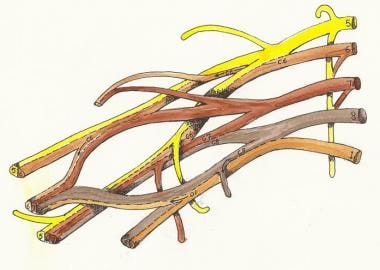Spinal nerves
Thirty one pairs of spinal nerves exist: 8 cervical, 12 thoracic, 5 lumbar, 5 sacral, and 1 coccygeal.
- Proximal branches: Each spinal nerve branches into a posterior root and an anterior root. The spinal or posterior root ganglion is occupied by cell bodies from afferent neurons. The convergence of posterior and anterior roots forms the spinal nerve. The cauda equina is formed by the roots arising from segments L2 to Co of the spinal cord.
- Distal branches: After emerging from the vertebral column, the spinal nerve divides into a posterior ramus, an anterior ramus, and a small meningeal branch that leads to the meninges and vertebral column. The posterior ramus innervates the muscles and joints of the spine and the skin of the back. The anterior ramus innervates the anterior and lateral skin and muscles of the trunk, plus gives rise to nerves leading to the limbs (see image below).
- Click to see the PDF chart: Nerve and nerve root distribution of major muscles.
- Cutaneous innervation and dermatomes: Each spinal nerve except C1 receives sensory input from a specific area of the skin called a dermatome. A dermatome map is a diagram of the cutaneous regions innervated by the branches of each spinal nerve, such a map is an oversimplification, however – each of you is unique as to what you feel.



0 Comments:
Post a Comment